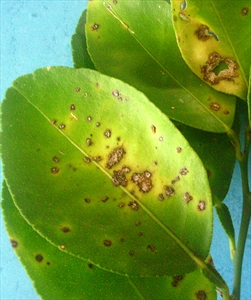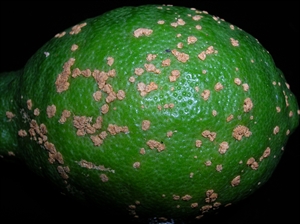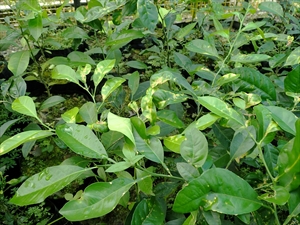Citrus bacterial canker. CABI prefers Asiatic citrus canker.
Pacific Pests, Pathogens, Weeds & Pesticides - Online edition
Pacific Pests, Pathogens, Weeds & Pesticides
Citrus canker (091)
Xanthomonas citri pv. citri. (It is also known as Xanthomonas citri subsp. citri, and previously as Xanthosomas axonopodis pv. citri). Strains of Xanthomonas pv. citri are recognised distinguished by host range.
Asia, Africa, North, South and Central America, the Caribbean, Europe, Oceania. There are four strains with different distributions. Citrus canker is recorded from Australia (Northern Territory), Fiji, Guam, Federated States of Micronesia, Marshall Islands, Palau, Papua New Guinea, and Solomon Islands.
Citrus species, including grapefruit, kumquat, lemon, lime, mandarin, orange, pomelo and tangerine, as well as other genera in the citrus family (Rutaceae), e.g., Fortunella and Poncirus.
Bacterial canker causes loss of plant vigour, leaves fall early, and fruit drop before it is mature. Fruits with canker infections are unsightly and cannot be sold. It is particularly serious on grapefruit, lemon, limes and oranges.
Brown raised spots - described as craters, pustules or blisters - occur on the leaves surrounded by yellow haloes (Photos 1&2). The spots are up to 10 mm diam., depending on time of infection and variety. They occur on both sides of the leaves (Photos 3&4). The centres of older spots fall out. Similar spots occur on the leaf stalks and twigs and these develop into cankers, causing stem or branch dieback. The spots on the fruit do not have yellow margins (Photo 5).
The disease is common in countries where it is hot with high rainfall. Infection occurs on young leaf flushes, stems and fruits, then declines as fewer new leaves are formed and fruits mature. It is common on seedlings in nurseries (Photo 6).
Short-distance spread occurs when water flows over the spots; bacteria ooze out of the spots and are spread by wind-driven rain and water-splash. They enter the leaves through natural openings, helped by winds of more than 30 kph, and wounds, especially those made by leafminers, Phyllocnistis citrella (see Fact Sheet no. 240). Pruning can also cause wounds which are entry points for bacteria.
Spread over long distances occurs during cyclones and on nursery plants. Canker lesions ooze bacteria, which are spread by strong winds. The winds also damage the trees and force the bacteria into natural openings and wounds. Spread also occurs on tools and other farm equipment, on people, birds and insects, on tree prunings and nursery plants.
The bacteria survive in the raised spots on leaves and fruit until they fall, and then for a few months in leaf litter in the soil. They also survive on weeds, some of which are infected.
The spots or blisters can be confused with citrus scab, a disease caused by a fungus (see Fact Sheet no. 48). However, leaves infected by citrus canker are not misshapen.
Bacterial canker is the most important disease of the citrus. It is of great concern to countries that have citrus industries that are yet free from the disease. Major citrus-growing countries, Australia, Brazil, and the USA, have all had incursions of the disease, some more than once, which have been extremely costly in efforts to eradicate. Some attempts have been successful, others not. The attempt to eradicate the 1995 introduction of the disease to Florida failed and was called off in 2006. Australia has been more fortunate and Queensland was declared free from the disease in 2009 after the destruction of large numbers of citrus of all kinds - commercial and backyard.
Look for the raised spots, light brown at first, gradually darkening and forming a crater, on leaves, stems and fruit. Hold the leaves to the light, and look for a water-soaked margin to the spot, surrounded by a bright yellow ring. Check that the leaves are not distorted or misshapen.
QUARANTINE
Canker is a disease of quarantine importance: countries free from the disease regulate the importation of citrus propagating material and fruit from those that have it.
If countries wish to import citrus germplasm, it should be under strict conditions following the FAO/IBPGR Technical Guidelines for the Safe Movement of Citrus Germplasm: http://www.bioversityinternational.org/e-library/publications/detail/faolbpgr-technical-guidelines-for-the-safe-movement-of-citrus-germplasm/. Note, more advanced techniques using PCR (polymerase chain reaction) are now part of indexing procedures.
CULTURAL CONTROL
There are a number of ways to reduce infection of canker where the disease is endemic, i.e., where it is well established and outbreaks occur regularly.
- Canker-free nurseries. This is an important part of the management of the disease. It is best to avoid overhead irrigation.
- Do not work in infected orchards when the foliage is wet from dew or rain.
- Windbreaks. Plant trees around blocks and/or between rows of large citrus plantations. A 10 m tall windbreak is effective for about 100 m. The distance between windbreaks depends on the susceptibility of the variety.
RESISTANT VARIETIES
Grapefruit, Mexican lime and trifoliate orange are highly susceptible to canker. Sour orange, sweet orange, lemon and lime are moderately susceptible, and mandarin moderately resistant. Preference should be given to Valencia orange and mandarin.
CHEMICAL CONTROL
Copper fungicides are effective in preventing fruit infection, but less so for leaf infection because leaves rapidly expand, exposing surfaces without copper protection. Apply two or three sprays 3 weeks apart, beginning when the fruits are about 5 mm diameter. The important time is 90 days after petal fall, when fruits are most susceptible.
Where leafminers are a problem, use a petroleum oil on flushes of foliage. Leafminers do not spread canker, but damage the leaf increasing the number of infections.
____________________
When using a pesticide, always wear protective clothing and follow the instructions on the product label, such as dosage, timing of application, and pre-harvest interval. Recommendations will vary with the crop and system of cultivation. Expert advice on the most appropriate pesticides to use should always be sought from local agricultural authorities.
AUTHORS Helen Tsatsia & Grahame Jackson
Information from CABI (2020) Xanthomonas citri (citrus canker). Crop Protection Compendium. (https://www.cabi.org/cpc/datasheet/56921); Citrus canker (2020) Department of Agriculture, Water and the Environment. (https://www.agriculture.gov.au/pests-diseases-weeds/plant/citrus-canker); Citrus canker (2019). Business Queensland. Queensland Government. (https://www.business.qld.gov.au/industries/farms-fishing-forestry/agriculture/crop-growing/priority-pest-disease/citrus-canker); and Plant Biosecurity and Product Integrity (2017) Citrus canker. Department of Primary Industries. NSW. Australia; and from Citrus canker (2019) Agriculture and Food. Department of Primary Industries and Regional Development. Government of Western Australia. (https://www.agric.wa.gov.au/citruscanker/citrus-canker). Photo 2 Kohler F, et al. (1997) Diseases of cultivated crops in Pacific Island countries. South Pacific Commission. Pirie Printers Pty Limited, Canberra, Australia. Photos 3-5 Richard Markham, ACIAR, Canberra.
Produced with support from the Australian Centre for International Agricultural Research under project PC/2010/090: Strengthening integrated crop management research in the Pacific Islands in support of sustainable intensification of high-value crop production, implemented by the University of Queensland and the Secretariat of the Pacific Community.









